Origins

The ancient family seat was 2,111-acre (8.54 km2) (as at 1870) Ogle, Northumberland, near Whalton. [2] There, Robert Ogle had the family's manor house licensed for crenellation in 1341, [3] or the previous year. [2]
The Ogle family were prominent landed gentry in Northumberland, England. The earliest appearances of the family name were written Hoggel, Oggehill, Ogille and Oghill. [1]

The ancient family seat was 2,111-acre (8.54 km2) (as at 1870) Ogle, Northumberland, near Whalton. [2] There, Robert Ogle had the family's manor house licensed for crenellation in 1341, [3] or the previous year. [2]
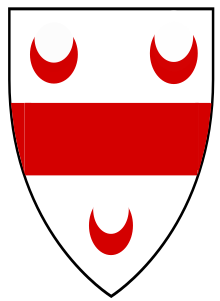
Sir Robert Ogle , Knight (24 Dec 1372–12 Aug 1436), was the son of Sir Robert "Richard" Ogle, Baron of Hepple, Knight, [3] [4] [5] of Ogle and Bothal Castles. [6] [7] In 1407, he was Constable of Norham Castle and Sheriff and Escheator of Norhamshire (an exclave of County Durham) and Islandshire (an exclave of County Palatinate of Durham) in the north of England. He represented Northumberland in Parliament six times between 1416 and 1435. In 1417 he was High Sheriff of Northumberland, and was appointed Warden of Roxburgh Castle in 1425. [6] [7]

He was also a key figure in the 15th century defence of the northern border against the Scots, but was beaten by Sir Alexander Ramsay at Piperden in 1436. [8]
Sir Robert married Matilda "Maud" Grey on c.21 May 1399, [6] [7] the only daughter of Thomas IV Grey, Constable of Norham (1359–1400) and Joan de Mowbray, and sister of John Grey, 1st Earl of Tankerville, and Thomas Grey (1384–1415). [6] Many of the extended family were involved in the Wars of the Roses on the Yorkist side.
As father of Robert Ogle, 1st Baron Ogle, Robert was the head of the family that included seven successive barons and many later junior branches. Catherine Ogle was the last of this main line. As the only surviving heir of Cuthbert Ogle, 7th Baron Ogle (d. 1597), she was created Baroness Ogle in 1628. In 1591 she married Sir Charles Cavendish of Welbeck. [9] They are the parents of William Cavendish, 1st Duke of Newcastle, and Earl of Ogle. [9] [10] [11]
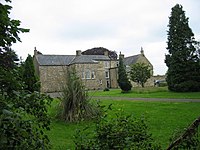
The manor of Causey Park was acquired with Bothal Castle, as a result of heiress Helen Bertram's first marriage to Robert Ogle, knight (d.1363). [3] [12]
William's great grandson James (1634–1664) married Jane Ogle of Burradon. As cousins, this marriage merged these two family branches. [13] His son William Ogle (1653–1718) was Member of Parliament for Northumberland from 1685 to 1689. [14]

Sir William Ogle of Choppington (1412 - 10 Aug 1474), was the third son of Maud Grey and younger brother of the first baron. [15] [16] He is also the ancestor of the American Ogle family from Colonial Maryland. [17] His son and heir was Gawen Ogle. [18] Around 1503, Gawen built a tower house at Choppington, then Bedlingtonshire (Northumberland), [19] of which no present trace remains. [20]
In 1569 and 1596, Gawen's grandson Oliver (d. 1616) acquired the Burradon manor near Longbenton, including a tower house in two tranches. [13] In 1633, Oliver's son Lancelot Ogle (1582–1640), improved the accommodation at Burradon Tower. After his daughter Jane Ogle of Burradon, married her cousin James Ogle of Causey Park, [13] the Burradon house was abandoned. By 1769 it was reported to be in ruins. William Wallace, Jane's grandson, inherited the estate. He changed his name to William Wallis Ogle, and sold the property outside of the family in 1857 [13]

Henry Ogle of Kirkley (1525–1580), grandson of the 3rd Baron Ogle held lands at Kirkley, near Whalton, Northumberland under Lord Eure. His sons Mark and Cuthbert (1569–1655) each bought a part of the Manor from Lord Eure around 1612. In 1632, Cuthbert built the manor Kirkley Hall, close to the site of the old house. [21]
Cuthbert's great grandson joined the navy, and ultimately became Admiral Sir Chaloner Ogle (1681–1750). [21]
Another great grandson Dr. Nathaniel Ogle (d. c. 1739) of Kirkley was an army physician under the Duke of Marlborough, [21] and was Deputy Lieutenant of Northumberland in 1715. His son Rev. Newton Ogle (1726–1804) was Prebendary of Durham Cathedral and Dean of Winchester Cathedral and in 1764 replaced the old house at Kirkley with a substantial mansion. [21]
Another son Chaloner Ogle (1726–1816) like his elder second cousin and namesake also joined the navy and became an Admiral. He was created a Baronet of Kings Worthy, Hampshire, in the year of his death. [21] For details of his successors see Ogle Baronets.
Rev. John Saville Ogle (1767–1853) son of Newton, was Canon of Salisbury Cathedral and prebendary of Durham Cathedral, and in 1832 he substantially extended and improved Kirkley Hall. [21] He repurchased from the Duke of Portland the ancient family estates at Ogle. [21]
The Kirkley estate was sold outside the family in 1922. [21]
For details of this branch see Ogle of Kirkley above and Ogle Baronets.

The Ogles of Eglingham were strongly Parliamentarian during the English Civil War. Robert Ogle of Eglingham rebuilt Eglingham Hall. He created a two-storey, seven-bayed mansion that incorporated the old manor as its west wing. The Ogles sold Eglingham Hall around 1900.[ citation needed ]
Henry Ogle of Eglingham, second son of William Ogle of Choppington and nephew of the first Baron, [15] acquired the Eglingham manor near Alnwick, Northumberland in 1514.
Luke Ogle of Eglingham (1510–1597) was a nephew of Henry. In 1565, he served as High Sheriff of Northumberland. He also built a new manor house (later to become known as Eglingham Hall) on the site of an existing pele tower.
Cpt. Henry Ogle of Eglingham (1600–1669) sequestered land for Parliament from 1643 to 1650. He also raised forces as a parliamentary commissioner from November/December 1644. [22]
Cpt. John Ogle of Eglingham (1621–1682/6) was the son of Henry's (1600-1669). In 1654, he served as High Sheriff of Northumberland during the Commonwealth. He married Eleanor Pringle. [23]
Henry Ogle of Eglingham (d. 1711) was the son of Cpt. John Ogle (1621–1682/6). He was High Sheriff of Northumberland in 1706/7. Henry married his first wife Apollina Howard in 1664. In November 1692, he married Grace Widdrington. [24]
Nicholas Ogle of Berwick and Bowsden (1605–1646) was the brother of Cpt. Henry Ogle of Eglingham (1600–1669), and the father of Rev. Luke Ogle of Berwick. [23]
Rev. Luke Ogle of Berwick. was the eldest son of Nicholas Ogle (1605-1646). Vocal in his views against the papacy, his open dissent during the Restoration led to his arrest and temporary confinement on a few occasions. [23] [25]
Samuel Ogle (1658–1718) was the son of Rev. Luke Ogle. He was recorder for Berwick and member of Parliament. [25] He was also Commissioner for the Colony of Maryland.
Samuel Ogle , was the grandson of Rev. Luke Ogle of Berwick. He fought at the siege of Fort William Henry[ citation needed ] and became Provincial Governor of Maryland in 1732 and began a dynasty in Maryland.
Benjamin Ogle (7 Feb 1749 – 6 Jul 1809) was Samuel's son. He was governor of Maryland from 1798 to 1801.
Benjamin Ogle Tayloe (May 21, 1796 — February 25, 1868) was Benjamin's grandson and an American businessman, bon vivant, diplomat, and political activist in Washington, D.C.
Towers [26]
Castles [26]

The title of Earl of Northumberland has been created several times in the Peerage of England and of Great Britain, succeeding the title Earl of Northumbria. Its most famous holders are the House of Percy, who were the most powerful noble family in Northern England for much of the Middle Ages. The heirs of the Percys, via a female line, were ultimately made Duke of Northumberland in 1766, and continue to hold the earldom as a subsidiary title.

Henry Percy, 8th Earl of Northumberland, 2nd Baron Percy was an English nobleman and conspirator.

Samuel Ogle was the 16th, 18th and 20th Proprietary Governor of Maryland from 1731 to 1732, 1733 to 1742, and 1746/1747 to 1752.
Baron Ogle is an abeyant title in the Peerage of England. It was created in 1461 for Robert Ogle. It fell into abeyance in 1691. The Ogles were a prominent Northumbrian family from before the time of the Norman Conquest. They settled at Ogle, Northumberland and in 1341 were granted a licence to fortify their manor house which became known as Ogle Castle. The family included seven Medieval Barons. Their estates fell by marriage to the Cavendish family following the death of the 7th Baron in 1597.
This is a list of the High Sheriffs of the English county of Northumberland. The High Sheriff is the oldest secular office under the Crown. Formerly the High Sheriff was the principal law enforcement officer in the county but over the centuries most of the responsibilities associated with the post have been transferred elsewhere or are now defunct, so that its functions are now largely ceremonial. The High Sheriff changes every March.
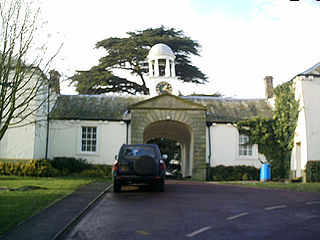
Ogle is a village in and former civil parish, now in the parish of Whalton, Northumberland, England, north-west of Ponteland and south-west of Morpeth. The surname Ogle comes from here, where the Ogle family built Ogle Castle and owned Kirkley Hall. In 1951 the parish had a population of 122.
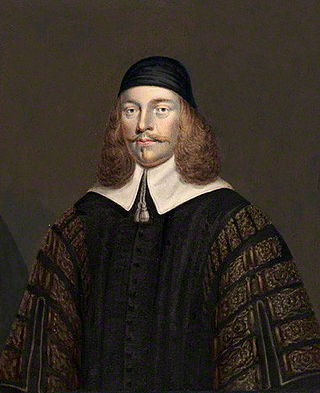
Sir Thomas Widdrington SL was an English judge and politician who sat in the House of Commons at various times between 1640 and 1664. He was the speaker of the House of Commons in 1656.

Kirkley Hall is a 17th-century historic country mansion and Grade II listed building in Northumberland, England. The estate is over 190 acres (0.77 km2) and adjoins the River Blyth at Kirkley, three miles north of Ponteland in the heart of the Northumberland countryside, which is now a Horticultural and Agricultural training centre.

Eglingham Hall is a former mansion house and a Grade II* listed building situated at Eglingham, near Alnwick, Northumberland.
Northumberland, was a County constituency of the House of Commons of the Parliament of England from 1290 to 1707, then of the Parliament of Great Britain from 1707 to 1800 and of the Parliament of the United Kingdom from 1801 to 1832. It was represented by two Members of Parliament.
The Selby family is a prominent and prolific family in the English gentry that originated in Selby, Yorkshire, but largely settled in Northumberland and County Durham. At various points through history, the family owned Biddlestone Hall and Twizell Castle in Northumberland in addition to the manor houses Ightham Mote in Kent and at Beal, Northumberland. The family had two baronetcies; the Selby and the Selby-Bigge but both are now extinct.
Burradon is a village in Tyne and Wear, England, to the north of Newcastle upon Tyne. It is adjacent to Camperdown and the two villages are closely linked. Camperdown was once known as Hazlerigge.
Sir John Forster (c.1520–1602) was an English military commander and Warden of the Middle Marches.

John Grey, 1st Earl of Tankervillejure uxoris6th Lord of Powys, KG, was an English peer who served with distinction in the Hundred Years' War between England and France under King Henry V.

Chirton Hall or Chirton House, occasionally spelled Churton and originally Cheuton, was a country house in Chirton, in what is now a western suburb of North Shields, Tyne and Wear, North East England. Historically, the house was in the county of Northumberland.
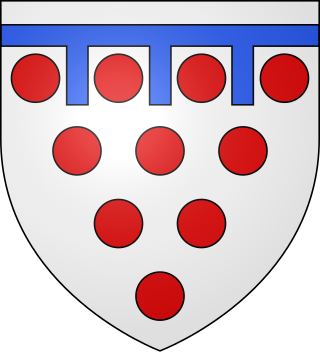
Babington is the name of an Anglo-Irish and English gentry family. The Anglo-Irish branch of the family is still extant today.

Sir Robert Ogle (c.1370–1436) of Ogle, Northumberland was an English landowner, Member of Parliament and administrator.
William Selby, was an English member of parliament and soldier at Berwick upon Tweed.

Sir Robert de Ogle was an English soldier and feudal landowner in Northumbria who fought in the border conflicts with Scotland. He captured five Scottish knights near Newcastle in 1341 and was licensed to crenellate Ogle House. He distinguished himself in resisting the foray into Cumberland of Sir William Douglas in 1345, fought at Neville's Cross in 1346 and took three nobles prisoner, and held Berwick Castle against the Scots in 1355.